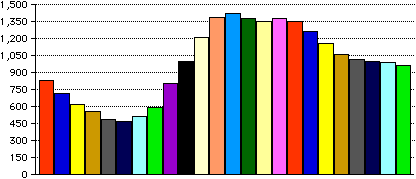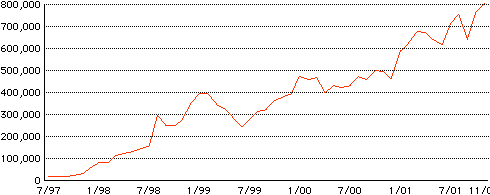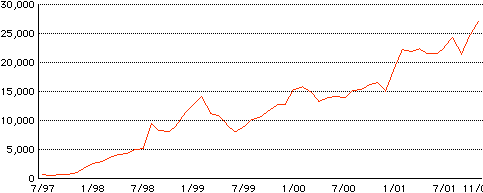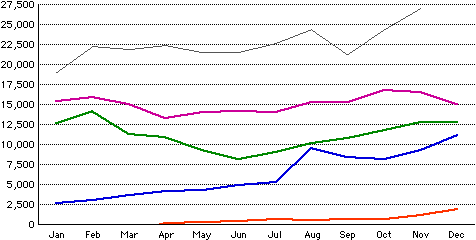The Knight Line
Number Crunching for Webmasters
Dan Knight - 2001.12.07
Okay, you've created your site and had it running for a while. But how much do you really know about what your visitors want? Have you analyzed your logs lately?
I run several sites, of which Low End Mac is the second oldest and the best known. Since April 1997, it's grown from nothing to the point where it now serves 800,000 pages a month to 200,000 visitors. Over that time, we've served somewhere in the vicinity of 20 million pages. Wow!
Ever since I discovered Analog, I've been looking at site statistics. I want to know what specific pages and what parts of the site are the most popular - and what parts of the site are of less interest. I started publishing pages listing the most popular pages each month and also over the previous three months. It helped me see patterns that changed over time.
Then I began looking at weekly and daily trends. With or without new content, Saturday and Sunday have about two-thirds as much traffic as weekdays. Mondays are a bit low, since they get off to a slow start, and Fridays are a bit low, since people try to clock out early and get a head start on the weekend.
Holidays are like weekends, coming in with about two-thirds as much traffic as weekdays. It's a very consistent pattern.
Another interesting discovery is that articles published on Friday tend to get more readers than those posted on Monday, even if I look at hits for the entire first week an article is up. In fact, we did an experiment with our weekly review of iBook and PowerBook news. By moving it to Monday, traffic dropped several hundred hits. Two months later we returned it to Friday and saw an immediate increase of several hundred hits. So although Friday's are slow, the next two days more than make up for it.
One thing I love about Analog is running it on the hour to see how traffic is going during the day. However, I came to hate their projection, which assumed a steady traffic pattern and was always well short of the mark. So I decided to create my own model based on hourly data for recent months. I discovered the pattern was consistent from month to month - and anything but steady, as this graph shows:

I have all of this in a spreadsheet that averages data over several months, giving more weight to recent months. I can plug in the number of hits at 7:00 a.m., noon, or 4:00 p.m., and the spreadsheet will give a pretty accurate projection for the whole day. Very nice.
The other important pattern is overall traffic. Is your site growing from month to month? What's the best way to compare February (with 28 days) and March (with 31)?
Here's the month-by-month traffic for Low End Mac, July 1997 to November 2001:

That shows a mostly steady growth pattern, except for early 1999. It's not a bad graph, but it could be improved. By taking the total number of pages served in a month and dividing by the total number of days, we address the 3% between 30 and 31 day months - and the problem of February being even shorter.
The graph showing average daily traffic is similar to the one above, but it also tends to be smoother since it factors in the different lengths of each month.

What we have in either case is a nice growth curve. The large jump in August 1998 coincides with the first shipment of Apple's iMac. There's a significant dip in September 2001, but we were all glued to the news that month. Both charts show a growth of 50-60% per year.
The next thing to look for is annual patterns. Are some months better or worse than others? Working with average daily traffic, not monthly totals, I created the following chart. The top line is 2001. Lines below that are 2000, 1999, 1998, and 1997, the year I began Low End Mac.

Some trends are fairly obvious:
- February is higher than January, which is higher than December
- March is generally down from February
- April through June traffic has been unpredictable
- July tends to be good - the Macworld Expo helps there
- Traffic tends to grow smoothly from June through November
- December has been a mixed bag
Looking at the patterns, weighting the figures, assuming growth slows over time, you can create a model. Our projections for average daily traffic at Low End Mac in 2002:
- January will be up at least 20% over December.
- February should be about 10% better than January.
- We'll see a 1-2% dip in March.
- April will roughly match March traffic.
- May has been a mixed bag, but will probably be down compared with April.
- We may see 1-2% growth in June.
- Traffic in July should increase 4-6% over June as we weigh vacations. against the summer Macworld Expo.
- August should be up at least 5% and possibly 8-10%.
- September will grow about 3% over August.
- October will also see 3-4% growth.
- November has always been good, possibly up 10% or more compared with October.
December has been too much of a mixed bag - way up two years, down in two, and pretty much even the other year. No specific prediction, but we should see 40-50% overall traffic growth at Low End Mac in 2002.
It'll be interesting to look back at Low End PC in two or three years and see how our traffic patterns will have developed.
Knowing the traffic patterns for your own site can help you decide what areas to focus on, when to plan vacations, and how many impressions you may be able to sell to advertisers or use for affiliate programs in the coming year.
I won't go into detail on how to build your own spreadsheet to
analyze the data in this column, but if you send me your questions,
I'll try to address them in another column next week.
![]()
Join us on Facebook, follow us on Twitter, or read Low End Mac's RSS news feed
Recent Content
Go to our home page for a listing of recent content.
About Low End PC Support Usage Privacy Contact

Follow
Low End PC on Twitter
Join Low End PC
on Facebook
Favorite Sites
MacWindows
Deal Brothers
DealMac
Affiliates
Amazon.com
The iTunes Store
PC Connection Express
Parallels Desktop for Mac
eBay

